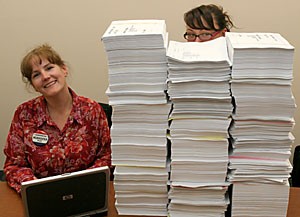The new Webroster program is designed to make the grading process easier and reduce the time it takes for students to receive their grades, although the system has its flaws, said employees in the Registrar’s Office.
The electronic grade processing system was pitched in early 2005 to the Faculty Senate, and the program had its first test after winter session.
“”The winter session test had its successes and problems, the primary problem being the load on the system the day before spring semester because it was the heaviest day of Web traffic, but there were no actual problems with the grading process,”” said senior associate registrar Beth Acree.
Another problem with the new program has been dealing with “”timing out”” issues and accessing the program.
“”I wish accessing the program was less cumbersome, and that getting into Webroster and being able to change the grades was a little simpler,”” said Richard Obregon, coordinator of studies in Mexican music with the School of Music.
There were also problems when instructors entered grades into the program.
Kodi Havins, a graduate teaching assistant in agricultural education, said when she was entering grades the program “”froze.”” With a class of 15 during winter session, Havins said it was not a problem, but if it happened during this semester with 150 students, it would have been.
Despite the glitches, the Registrar’s Office has learned from the limitations and is confident that the program will work smoothly for spring semester, Acree said.
Webroster’s main purpose is to improve the paper grading system with a completely online way to process grades.
“”The fact that the process is more accurate and less likely for students to get assigned a grade that is wrong is one of the best features,”” Acree said.
Through Webroster, 56 percent of classes were assigned to instructors and 359 administrative drops were completed for the spring 2007 semester.
Before the use of Webroster, processing grades was done with bubble sheets and a complex process that took days to complete.
“”The most glaring problem that the Registrar’s Office had was the amount of paper we had to deal with for grading,”” Acree said. “”Just keeping track, sorting and distributing was a difficult task, and it’s easy for papers to get lost in the office.””
One fear that officials in the Registrar’s Office had with paper grade sheets is they may sit in mailboxes for long periods of time, allowing for anyone to change grades, Acree said.
“”With this new system, we are not having to send paper back and forth from colleges to departments, to instructors and then back again,”” Acree said. “”This process takes three days out of the grading process and it goes through an electronic system.””
Grades that once could be left blank on paper must now be filled in electronically because the program will not accept a blank grade. The program also allows for departments to see who has submitted grades and who hasn’t, which was difficult to determine before, Acree said.
The Registrar’s Office is offering demonstrations of the program to all instructors so that they may use the program throughout the spring semester.
“”It is challenging to get the word out about the program, and it will take some time,”” Acree said. “”But we have been getting raves from department staff; they are the people who actually have to keep track of grades.””









